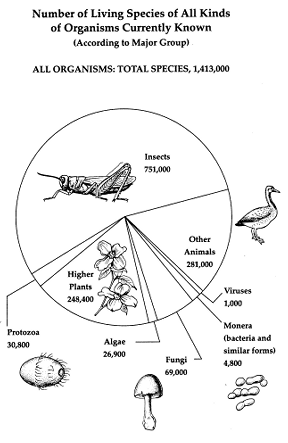Life on Earth: Diversity and AdaptationOne of the hallmarks of life on Earth is its astonishing diversity. No one really knows for sure how many different species occupy the Earth, with current estimates falling anywhere between 10 and 100 million species (Wilson, 1992). Of those, only a small fraction are known to science even well enough to have a name (about 1,413,000 species have been named, Figure 1 below). For far fewer species is much of anything known about the details of the lives they lead on our planet.
Figure. 1. Organisms of the world, by numbers of named species. From Wilson (1992), p. 135. From what we do know, however, it is clear that organisms make their living in an amazing array of different ways. Life on Earth may have one cell or many. Some organisms (plants) make their own food by capturing energy from the sun, others eat plants directly or eat the herbivores. Virtually every multicellular organism has other organisms that live in it or on it, and still others use dead biological material for food. The array of sizes ranges over orders of magnitude, from microscopic bacteria to free-living animals that can weigh tons, to fungi in which a single organism may occupy hundreds of square miles of soil. Finally, organisms come in all shapes (Figure 2 below), from those lacking any symmetry (such as sponges, Phylum Porifera) to the radially symmetrical jellyfish and corals (Phylum Cnidaria), to the bilaterally symmetrical higher invertebrates and vertebrates (Phylum Chordata). As if this weren't enough, the fossil record shows us that even more bizarre forms once lived on Earth. During the Cambrian period, and preserved in the Burgess Shale fossil deposits from British Columbia, we can see organisms with shapes not present in any living organism, that are so different they fit into no phylum that is currently alive. So, life on Earth has been even more diverse than it is today. Of these millions of different species, only one, Homo sapiens, is classified as "intelligent life". For various reasons discussed below, the probability that life in any form could occur in other universes is a much broader question than the probability that "intelligent" life could be found elsewhere.
Figure. 2. A simple classification scheme for the major phyla of animals. Some of the key innovations that occurred during animal evolution are indicated in the ovals. Note that the invertebrate lineage most closely related to Chordates are the starfish and sea urchins (Phylum Echinodermata). From Audesirk/Audesirk, BIOLOGY: Life On Earth, 5/e, © 1999. Electronically reproduced by permission of Pearson Education, Inc., Upper Saddle River, New Jersey. Figure 22-1. The second defining feature of life on Earth is adaptation. An adaptation can be defined as a biological characteristic that suits an organism to the particular environment in which it lives. Adaptations may be seen in nearly all aspects of the size, shape and coloration of organisms, as well as in the biochemical and physiological details of how organisms work. For example, the praying mantis is shaped and colored just like the plants in the habitat it occupies. This resemblance to the background (crypticity) permits the mantis to effectively stalk its prey while concealing itself from its own predators. The converse of crypticity is seen in plants with brightly colored flowers that attract pollinators, or dangerous and/or distasteful creatures with orange or yellow and black warning coloration, such as bees and wasps. These warning colors signal "Don’t mess with me or you'll be sorry". Both of these types of coloration (cryptic and warning) are adaptations that provide these organisms with enhanced survival or reproduction in their particular environment. Adaptations can also be seen in how organisms work. The mechanics of flight in insects and birds has lead to exquisite engineering modifications of structure with accompanying adaptations in muscle physiology, circulation and respiration. The ability of a male moth to detect the scent of a female from 2 miles away, using highly elaborated sensory organs on the antennae is an adaptation, as is the organ in pit vipers that permits detection of warm-blooded prey objects in the dark.
Contributed by: Dr. Sara Via |







